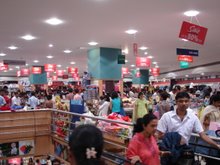Mall mania gives a lift to elevator companies
IT’S THE mall mania and it looks like the escalator manufacturers are taking a stairway to heaven. The long strip of moving stairways that relieve shoppers of many a legwork is a Rs 400-crore business in India. The coming three years is expected to be nothing short of heaven for escalator manufacturers, as an additional 500 malls would become operational. As per retail experts, around 4,000 escalators would be required over the next two years to cater to this demand. Leading manufacturers like OTIS, Kone, Schindler, Thyssen and Johnson are pulling up their act by ramping up operations and bringing in latest technology and product features.Close to 2,000 escalators were sold in 2007. Around 50% of the demand for escalators came from malls, and the rest from airports, hotels, convention centres and railway stations. OTIS is by far, the largest player in the world, with a market share of 35% and the Indian market is not expected to be any different. One unit of an escalator (that leads you from one floor to another) typically costs between Rs 12 to Rs 25 lakh. The price varies based on the length, brand, technology and other specific requirements. For instance, the cost of an escalator increases as it gets installed at higher floors and so on. There are no ballpark estimates as to the extent of escalator and elevator that would go for, say, a million square feet of mall space. This is because the mall designs are different and so are the traffic estimates. Says Dharmesh Jain, CMD of Nirmal Lifestyle: “Mall designers mainly decide on the placement (of the escalator), while consultants decide on the vendors. We have requirements for 100 escalators for the 3.6 million sqft of retail space and we are most likely to prefer one vendor per project”. OTIS recently got orders for 62 elevators and 28 escalators for the 1.1 million sqft Dreams mall in Mumbai. A section of the industry feels that the West is more scientific in its approach towards determining the optimal number of escalators and elevators for a mall than the local players. “While the primary role of the vertical transportation system is to enable least resistance (in flow of traffic), the current design and selection priority focuses on making it part of the attraction, even to the extent of totally neglecting the primary role,” says TAK Mathews, associate, TAK & Associate, an independent vertical transportation consultant. While proper placement of escalators is no assurances of sales for its tenants, the attempt is to ensure the shoppers are forced to see a whole range of tenants before exiting. For instance, an anchor tenant, who could be a multiplex or a food court, could be placed at the top floor to drive traffic. The escalators could be placed in such a manner that the shoppers are forced to see a whole range of tenants on their way up and down. This not only provides maximum exposure to the sub-tenants, but also leads to impulse purchase. But then, the game plan could for a toss if a holistic view is not taken. Mr Mathews cites the example of how, in a certain mall the anchor tenant placed strategically at the top-most floor didn’t get the intended traffic as only two lifts were installed creating congestion downstairs. People preferred to stroll on the ground floor instead.
Courtesy: EconomicTimes
For more detail on Retail India visit: http://www.retailindia.tv/


No comments:
Post a Comment